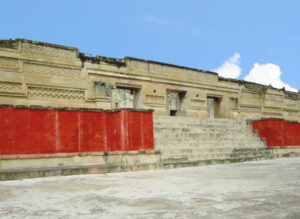
For reasons that are still not completely understood, the Zapotec began to abandon their ancient and exceptionally well-defended capital of Monte Alban sometime in the 1st century CE.
Sometime soon after abandoning their great capital, the Zapotec began construction of a new settlement we today call by its Nahuatl name, Mitla, but was then known as Yooꞌ Baꞌ — the place of rest or place of the dead.
 Today Mitla is in the middle of a town of the same name, in Oaxaca, Mexico. Though the best preserved and restored structures lay within the federally protected archaeological site itself, temples and tombs can be found across the community in backyards and agave plantations.
Today Mitla is in the middle of a town of the same name, in Oaxaca, Mexico. Though the best preserved and restored structures lay within the federally protected archaeological site itself, temples and tombs can be found across the community in backyards and agave plantations.
Mitla’s influence began to grow through the entirety of the first and second half of the second millennia of our era and still had an active ceremonial center by the time the Spanish arrived in the 16th century.The  Spanish arrived in Mitla with a considerable army commanded by Europeans but mostly comprised of Mesoamerican mercenaries and upstarts looking for a favorable position under the new order.
Spanish arrived in Mitla with a considerable army commanded by Europeans but mostly comprised of Mesoamerican mercenaries and upstarts looking for a favorable position under the new order.
 Spanish arrived in Mitla with a considerable army commanded by Europeans but mostly comprised of Mesoamerican mercenaries and upstarts looking for a favorable position under the new order.
Spanish arrived in Mitla with a considerable army commanded by Europeans but mostly comprised of Mesoamerican mercenaries and upstarts looking for a favorable position under the new order.Late in the same century, the Spanish began construction of the Temple of Saint Paul using materials from the surrounding Mesoamerican structures.
Mitla’s ceremonial center is laid out in self-contained patios reminiscent of Monte Alban, though on a smaller scale.
Like several other Zapotec ancient cities, Mitla also features a number of internal patios surrounded by highly ornate structures which served as palaces for the local elite.
The elegance of their geometry aside, these patios are also notable for the surviving frescoes which survive on their walls and lintels.
 Like all major Zapotec settlements, Mitla is known for its many elaborate tombs, more often than not adorned with images making reference to the Mesoamerican deity, Mixcóatl.
Like all major Zapotec settlements, Mitla is known for its many elaborate tombs, more often than not adorned with images making reference to the Mesoamerican deity, Mixcóatl.
When entering the site, you will immediately notice the intricate geometrical designs that characterize Zapotec facades and art more generally since before the advent of a Zapotec script or a truly centralized political system.

One of the most interesting aspects of these ancient designs is that they are still extremely common in contemporary artworks in Oaxaca, including the tapestries the state is so well known for.

Aside from its tombs and frescoes, Mitla is also famous for the exceptional state of conservation of much of the paint on the facade of several of its structures, though these have of course been restored by INAH. The red paint found on the structures of Mitla was made by grinding small insects called cochinilla, which are found on certain species of cacti, with other materials such as limestone. The higher the concentration of the cochinilla, the more vibrant the resulting color. [Note: The photo has been Photoshopped to “take out” several tourists.]
If you go
 Given its fame and proximity to the city of Oaxaca, tours to Mitla are easy to find and usually also include a visit to the petrified waterfalls of Hierve el Agua and one or two textile shops.
Given its fame and proximity to the city of Oaxaca, tours to Mitla are easy to find and usually also include a visit to the petrified waterfalls of Hierve el Agua and one or two textile shops.
Though these other stops are worth it, if you are mainly interested in Mitlas’ archaeology, the best course of action is to take a taxi or bus to Mitla – it’s only 44 km. Spend the night to ensure you are able to get in as early as possible and beat the crowds.




Leave a Reply